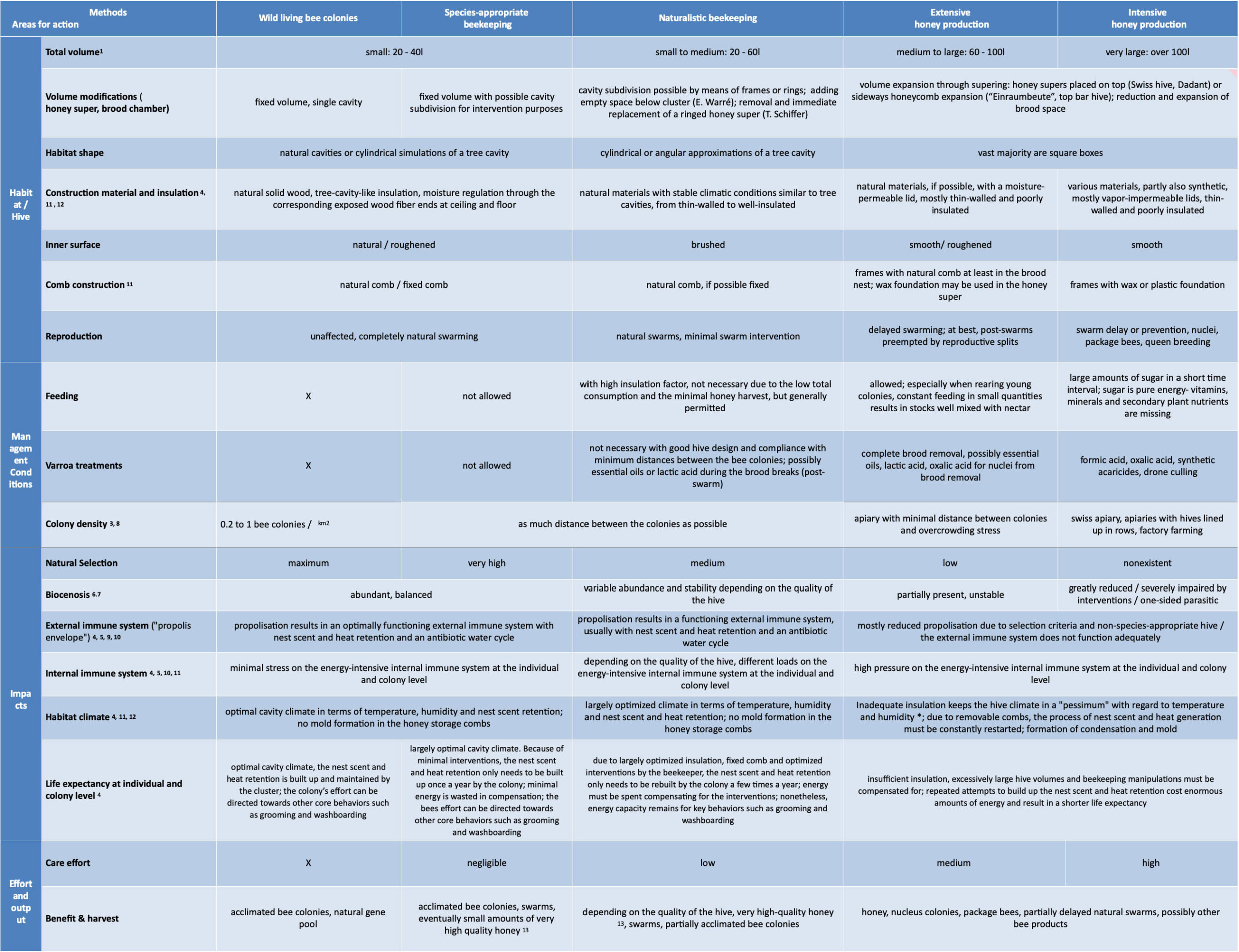Beekeeping methods
How intensively am I managing my bees?
Revised FREETHEBEES beekeeping methodology.
There are more and more beekeepers who keep their honey bees for the love of nature and not primarily to maximise honey yield. Nevertheless, their method of beekeeping is often similarly “intensive” to that of the honey yield beekeeper. Across Europe, there are currently no clear criteria for recording the intensity of honey bee management.
FREETHEBEES has described different types of operation and classified them in terms of their production intensity. In the revised beekeeping methodology, extensive, sustainable and species-appropriate beekeeping is described and expanded by the influence of bee housing. The wild honey bee in its most natural habitat – the tree cavity – is also included. The criteria that influence the intensity of beekeeping, the climate in the hive, the factors for natural and species-appropriate husbandry are discussed, and intensive honey beekeeping is contrasted with extensive beekeeping.
The key lies in diversifying beekeeping methods!
Apart from securing the share of pollination and a domestic honey production with extensive beekeeping as far as possible, every contribution of beekeepers is required for the “ecological and evolutionary balance”. In practice, a beekeeper can, for example, subject 80% of his colonies to the criteria of extensive honey beekeeping and produce just as much honey as before, but in a significantly more sustainable way, more appropriate to the species and, moreover, completely free of chemicals. He keeps 20% of the colonies close to nature and thus produces an “ecological and evolutionary compensation contribution” for the benefit of nature as well as for the protection and promotion of the wild bee population.
Practical classification table
The classification table below is intended as a guide to help beekeepers assess their own level of intensity and to give them indications of how they can classify, critically question and purposefully optimise their own working methods.
Detailed explanations for the derivation and handling of the FREETHEBEES beekeeping method
FREETHEBEES Beekeeping Methodology – Classification Table
1Loftus JC, Smith ML, Seeley TD (2016) How Honey Bee Colonies Survive in the Wild: Testing the Importance of Small Nests and Frequent Swarming. PLoS ONE 11 (3): e0150362. doi: 10.1371 / journal.pone.0150362.
2Wermelinger A (2013) Contemporary and targeted beekeeping methods. https://freethebees.ch/wp-content/uploads/2013/03/2013_03_29-Zeitgemaesse-und-zielgerichtete-Imkermethoden_v11.pdf 24.05.20 / 18.15
3Seeley TD (2015), Crowding honeybee colonies in apiaries can increase their vulnerability to the deadly ectoparasite Varroa destructor. Apidologie (2015) 46:716–727. DOI: 10.1007/s13592-015-0361-2.
4Evolution der Bienenhaltung – Artenschutz für Honigbienen. Torben Schiffer, Ulmer Verlag, 2020 ISBN 978-3-8186-0924-5.
5The lives of bees – The untold story of honey bees in the wild. Thomas D. Seeley, Princeton University Press, 2019, ISBN 978-0-691-16676-6.
6Biocenosis is a community of organisms of different species in a definable habitat (biotope, here the hive). Biocenosis and biotope together form the ecosystem (bee colony, honeycomb structure, “cavity”, roommates) https://de.wikipedia.org/wiki/Bioz%C3%B6nose 13.05.18 / 18.32
7http://freethebees.ch/wp-content/uploads/2017/11/FourSimpleSteps_Michael_Bush-klein.pdf 06.06.18 / 17.35: “More than 30 other insect species, more than 170 arachnid species (including the book scorpion), more than 8000 microorganisms (Fungi, bacteria, viruses)”.
8Kohl PL, Rutschmann B (2018), The neglected bee trees: European beech forests as a home for feral honey bee colonies. PeerJ 6: e4602; DOI 10.7717 / peerj.4602
9Borba RS, Spivak M (2017) Propolis envelope in Apis mellifera colonies supports honey bees against the pathogen, Paenibacillus larvae.Scientific REPOrtS | 7 : 11429 | DOI: 10.1038 / s41598-017-11689-w
10Ehrler S, Moritz RFA (2016) Pharmacophagy and pharmacophory: mechanisms of self-medication and disease prevention in the honeybee colony (Apis mellifera ). Apidology 47: 389-411. DOI: 10.1007 / s13592-015-0400-z
11Mitchell D (2015) Ratios of colony mass to thermal conductance of tree and man-made nest enclosures of Apis mellifera: implications for survival, clustering, humidity regulation and Varroa destructor Int J Biometeorol, published online: 03 September 2015
12Thür J (1946) Beekeeping. Natural, simple and sure of success. Friedrich Stock’s Nachf. Karl Stropek book shop and antiquarian bookshop, Vienna. 1. Part The law of nest scent and heat retention, the basis for health, prosperity and yield. P. 5-12
13 Heaf D (2016) Bee guided pharmacognosy? BBKA News Incorporating the British Bee Journal July 2016
* The pessimum denotes the least favorable environmental condition under which an organism can survive. In contrast, the optimum is. https://de.wikipedia.org/wiki/Pessimum 01.01.20 /19.38

